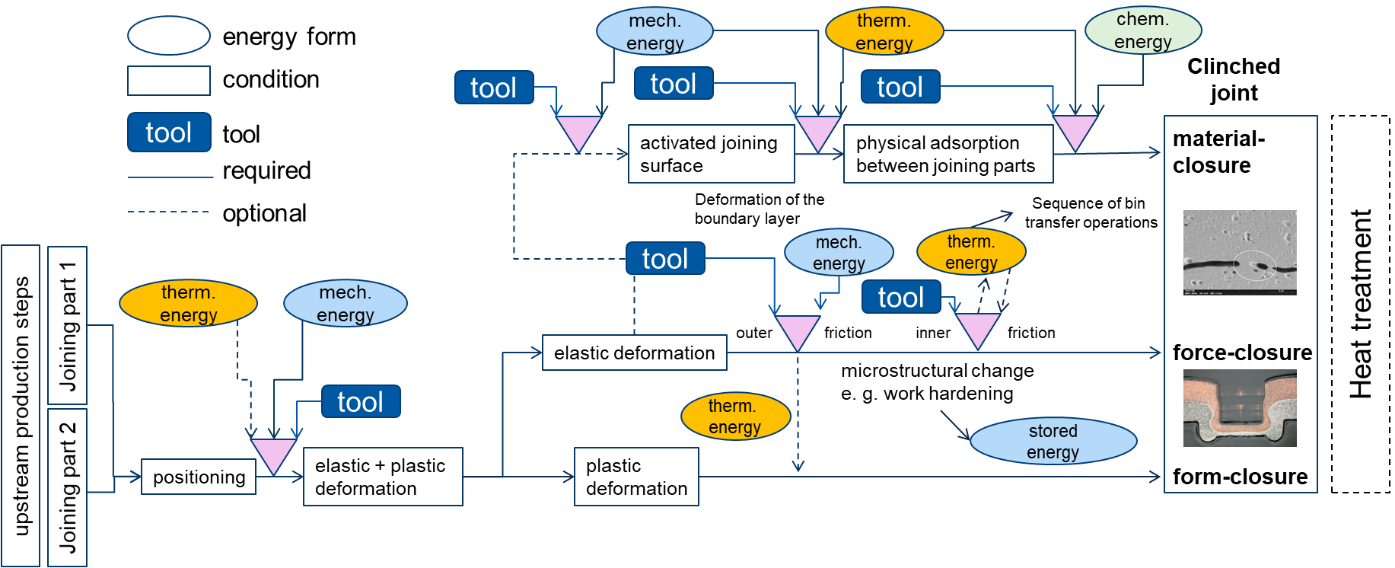A04 - Modelling of joint ability as function of the binding mechanism
Multi-material design and the versatility of a process chain require joints with specifically adjustable mechanical, thermal, chemical or electrical properties, whereby previous considerations have primarily addressed the mechanical properties. Due to the large number of possible combinations of requirements, materials and component or joint geometry, a comprehensive empirical determination of these joint properties is not possible. The technological parameters already stored in databases, such as the shear strength as a function of the materials used and the joint design, often serve only as a guide value that must be verified experimentally on the basis of the actually executed joint. As a result of this established and empirically based procedure, no model exists to date that considers all issues of joinability, i.e. the materials (suitability for joining), the design (safety of joining) and the manufacturing (possibility of joining).
The aim of subproject is to describe the physical properties of the joint as a function of the binding mechanisms force-closure, form-closure and if occur, material-closure by means of a suitable modeling approach. The scientific problem consists in the quantifiable formulation of the individual binding mechanisms on the basis of energies and energy flows, which is not yet available. A distinction is made between supplied, stored and dissipated energy. The energy balances are used to detect the individual binding mechanisms and correlate them with the resulting properties. This energetic observation enables a statement of the correlations along the causal chain "joint requirement - binding mechanism - energy - joining parameter". In this way, the versatility of mechanical joining technology can be improved.
Within the subproject, the proportions of the binding mechanisms form-closure, force-closure and material closure are analyzed using the example of clinch joints. The resulting description of the relationship between the properties of the joint and the binding mechanism, as well as the energy balance, is verified experimentally by means of metallographic analyses and selected technological tests, as well as by measuring the electrical resistance of joined components. In the final synthesis step, the model is formulated, using both phenomenological approaches to describe the effects and analytical approaches. The two types of modeling allow for different simulation methods. Phenomenological modeling can be used for initial, rapid joint design and evaluation under simplifying geometric assumptions. Analytical modeling enables precise calculation based on finite element simulation results in post-processing.
The subproject cooperates with the projects that deal with the design of the joint connections. The object of the cooperation is the mutual verification of the different, methodologically divergent modeling and design strategies. The phenomenological regularities provided by this subproject allow the other subprojects to perform plausibility checks and model adaptations. Further cooperation takes place with the subprojects that characterize the damage behavior of the joint. Here, information is exchanged with regard to the changing proportions of the bonding mechanisms over the lifetime of the joint. Furthermore, cooperation takes place with the projects that consider a sensitivity of the process chain and in particular address the cause-effect principle. The object of the cooperation is the model validation and robustification of the processes or the entire process chain.
Bindemechanismen
Publications
Influence of the production process on the binding mechanism of clinched aluminum steel mixed compounds
J. Kalich, U. Füssel, Journal of Manufacturing and Materials Processing 5 (2021) 105.
Numerical and experimental investigation of the transmission moment of clinching points
C. Steinfelder, J. Kalich, A. Brosius, U. Füssel, IOP Conference Series: Materials Science and Engineering 1157 (2021) 012003.
Effect of Different Tool Geometries on the Mechanical Properties of Al-Al Clinch Joints
L. Ewenz, J. Kalich, M. Zimmermann, U. Füssel, Key Engineering Materials 883 (2021) 65–72.
Design of clinched joints on the basis of binding mechanisms
J. Kalich, U. Füssel, Production Engineering (2022).
The Influence of Heat Treatment on the Microstructure, Surface Roughness and Shear Tensile Strength of AISI 304 Clinch Joints
A.T. Zeuner, L. Ewenz, J. Kalich, S. Schöne, U. Füssel, M. Zimmermann, Metals 12 (2022).
Long-Term Behavior of Clinched Electrical Contacts
J. Kalich, M. Matzke, W. Pfeiffer, S. Schlegel, L. Kornhuber, U. Füssel, Metals 12 (2022).
Electrical Contacting of Aluminum Bus Bars Using Clinching and Functional Elements
U. Füssel, S. Schlegel, G. Reschke, J. Kalich, in: SFU/ICAFT 2022, MDPI, 2022.
Clinching of Aluminum Materials – Methods for the Continuous Characterization of Process, Microstructure and Properties
R. Kupfer, D. Köhler, D. Römisch, S. Wituschek, L. Ewenz, J. Kalich, D. Weiß, B. Sadeghian, M. Busch, J.T. Krüger, M. Neuser, O. Grydin, M. Böhnke, C.R. Bielak, J. Troschitz, Journal of Advanced Joining Processes 5 (2022).
Review on mechanical joining by plastic deformation
G. Meschut, M. Merklein, A. Brosius, D. Drummer, L. Fratini, U. Füssel, M. Gude, W. Homberg, P.A.F. Martins, M. Bobbert, M. Lechner, R. Kupfer, B. Gröger, D. Han, J. Kalich, F. Kappe, T. Kleffel, D. Köhler, C.-M. Kuball, J. Popp, D. Römisch, J. Troschitz, C. Wischer, S. Wituschek, M. Wolf, Journal of Advanced Joining Processes 5 (2022).
Methoden zur Charakterisierung der Bindemechanismen bei geclinchten elektrischen Kontakten
G. Reschke, J. Kalich, U. Füssel, in: M. Zimmermann, DGM - Deutsche Gesellschaft für Materialkunde e.V. (Eds.), Tagung Werkstoffprüfung 2022: Werkstoffe und Bauteile auf dem Prüfstand, Prüftechnik – Kennwertermittlung – Schadensvermeidung, Sankt Augustin, 2023, pp. 374–379.
Prozessüberwachte Eigenschaftseinstellung beim Clinchen der ausscheidungshärtbaren Aluminiumlegierung EN AW-6014
S. Lüder, J. Kalich, H. Oesterle, H.C. Schmale, in: U. Krupp, I. Steller, Stahlinstitut VDEh (Eds.), Tagung Werkstoffprüfung 2024: Werkstoffe und Bauteile auf dem Prüfstand, Prüftechnik – Kennwertermittlung – Schadensvermeidung, Düsseldorf, 2024, pp. 205–210.
Application of stress-state-dependent ductile damage and failure model to clinch joining for a wide range of tool and material combinations
J. Friedlein, S. Lüder, J. Kalich, H.C. Schmale, M. Böhnke, M.C. Schlichter, M. Bobbert, G. Meschut, P. Steinmann, J. Mergheim, Journal of Advanced Joining Processes 11 (2025).
Analysis of the binding mechanisms depending on versatile process variants of self-piercing riveting
S. Lüder, P.K. Holtkamp, S. Wituschek, M. Bobbert, G. Meschut, M. Lechner, H.C. Schmale, in: G. Meschut, M. Bobbert, J. Duflou, L. Fratini, H. Hagenah, P.A.F. Martins, M. Merklein, F. Micari (Eds.), Materials Research Proceedings, Materials Research Forum LLC, Millersville, 2025, pp. 101–108.
Investigation of the impact of a rotationally superimposed punch stroke on the binding mechanisms of a clinched joint
S. Lüder, E. Wolf, H.C. Schmale, A. Brosius, in: MATEC Web of Conferences, EDP Sciences, 2025.
Show all publications




